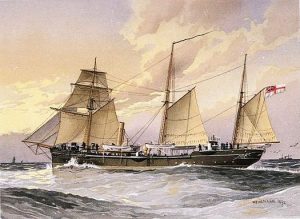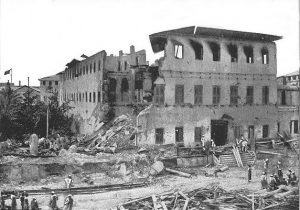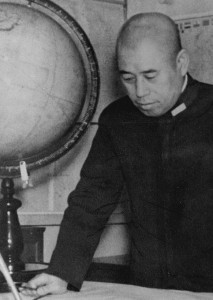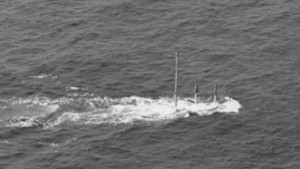admiral
 Some wars can last for years and years, while others are relatively short lived, but no war, at least to date, has been as short as the Anglo-Zanzibar War that was fought on August 27, 1896. The war was so short, that it is estimated to have lasted between 38 and 40 minutes…yes, I said minutes. The cause of the war was the sudden and unexplained death of pro-British Sultan Hamad bin Thuwaini, followed by the subsequent succession of Sultan Khalid bin Barghash, who was suspected of killing his uncle in order to take over. The British authorities preferred Hamud bin Muhammed, who was well known for his favorable stance toward British interests. A treaty signed in 1886, called for any candidate for accession to the sultanate, to be approved by the British consul, and Khalid had not fulfilled this requirement. The British considered this an act of war and sent an ultimatum to Khalid demanding that he order his forces to stand down and leave the palace. In response, Khalid called up his palace guard and barricaded himself inside the palace.
Some wars can last for years and years, while others are relatively short lived, but no war, at least to date, has been as short as the Anglo-Zanzibar War that was fought on August 27, 1896. The war was so short, that it is estimated to have lasted between 38 and 40 minutes…yes, I said minutes. The cause of the war was the sudden and unexplained death of pro-British Sultan Hamad bin Thuwaini, followed by the subsequent succession of Sultan Khalid bin Barghash, who was suspected of killing his uncle in order to take over. The British authorities preferred Hamud bin Muhammed, who was well known for his favorable stance toward British interests. A treaty signed in 1886, called for any candidate for accession to the sultanate, to be approved by the British consul, and Khalid had not fulfilled this requirement. The British considered this an act of war and sent an ultimatum to Khalid demanding that he order his forces to stand down and leave the palace. In response, Khalid called up his palace guard and barricaded himself inside the palace.
At 9:00am East Africa Time on 27 August, the ultimatum expired. The British had gathered three cruisers, two gunboats, 150 marines and sailors, and 900 Zanzibaris in the harbor area. The Royal Navy contingent were  under the command of Rear-Admiral Harry Rawson while their Zanzibaris were commanded by Brigadier-General Lloyd Mathews of the Zanzibar army, who was also the First Minister of Zanzibar. Around 2,800 Zanzibaris defended the palace, most of whom were recruited from the civilian population, but they also included the sultan’s palace guard and several hundred of his servants and slaves. The defenders had several artillery pieces and machine guns, which were set in front of the palace sighted at the British ships. The first bombardment, launched at 9:02am quickly set the palace on fire, disabling the defending artillery. A small naval action took place in the harbor, with the British sinking the Zanzibari royal yacht HHS Glasgow and two smaller vessels. The palace fired some shots ineffectually at the pro-British Zanzibari troops as they approached the palace. The flag at the palace was shot down and fire ceased at 9:40am. It was almost a matter of ready…aim…oh, never mind.
under the command of Rear-Admiral Harry Rawson while their Zanzibaris were commanded by Brigadier-General Lloyd Mathews of the Zanzibar army, who was also the First Minister of Zanzibar. Around 2,800 Zanzibaris defended the palace, most of whom were recruited from the civilian population, but they also included the sultan’s palace guard and several hundred of his servants and slaves. The defenders had several artillery pieces and machine guns, which were set in front of the palace sighted at the British ships. The first bombardment, launched at 9:02am quickly set the palace on fire, disabling the defending artillery. A small naval action took place in the harbor, with the British sinking the Zanzibari royal yacht HHS Glasgow and two smaller vessels. The palace fired some shots ineffectually at the pro-British Zanzibari troops as they approached the palace. The flag at the palace was shot down and fire ceased at 9:40am. It was almost a matter of ready…aim…oh, never mind.
Sultan Khalid bin Barghash’s forces sustained roughly 500 casualties, while the British only had one sailor injured. Sultan Khalid immediately ran to the German consulate, where he was given asylum and then he escaped to German East Africa, located in the mainland part of present day Tanzania. The British quickly placed Sultan Hamud bin Muhammed in power at the head of a puppet government. The war marked the end of the Zanzibar Sultanate as a sovereign state and the start of a period of heavy British influence. The badly damaged palace complex was completely changed by the war. The harem, lighthouse and palace were demolished as the  bombardment had left them unsafe. The palace site was turned into an area of gardens, and a new palace was erected on the site of the harem. The House of Wonders was almost undamaged and would later become the main secretariat for the British governing authorities. During renovation work on the House of Wonders in 1897, a clock tower was added to its frontage to replace the lighthouse lost to the shelling. The wreck of the Glasgow remained in the harbor in front of the palace, where the shallow waters ensured that her masts would remain visible for several years to come, as a reminder of what would happen if the treaty was not followed. In 1912, it was finally broken up for scrap.
bombardment had left them unsafe. The palace site was turned into an area of gardens, and a new palace was erected on the site of the harem. The House of Wonders was almost undamaged and would later become the main secretariat for the British governing authorities. During renovation work on the House of Wonders in 1897, a clock tower was added to its frontage to replace the lighthouse lost to the shelling. The wreck of the Glasgow remained in the harbor in front of the palace, where the shallow waters ensured that her masts would remain visible for several years to come, as a reminder of what would happen if the treaty was not followed. In 1912, it was finally broken up for scrap.
 Some soldiers, no matter what side they are on or what branch of service they are in, are so good at what they do, that they become a must kill to the enemy. Admiral Isoroku Yamamoto was just such a soldier. Yamamoto held several important posts in the Imperial Japanese Navy, and undertook many of its changes and reorganizations, especially its development of naval aviation. He was the commander-in-chief during the early years of the Pacific War and so was responsible for major battles such as Pearl Harbor and Midway. That meant that the Unites States had a score to settle with the admiral. Nevertheless, this would be no easy task. The Japanese codes were difficult to break, and so locating the admiral at a time when they could be prepared to shoot him down was not going to be easy.
Some soldiers, no matter what side they are on or what branch of service they are in, are so good at what they do, that they become a must kill to the enemy. Admiral Isoroku Yamamoto was just such a soldier. Yamamoto held several important posts in the Imperial Japanese Navy, and undertook many of its changes and reorganizations, especially its development of naval aviation. He was the commander-in-chief during the early years of the Pacific War and so was responsible for major battles such as Pearl Harbor and Midway. That meant that the Unites States had a score to settle with the admiral. Nevertheless, this would be no easy task. The Japanese codes were difficult to break, and so locating the admiral at a time when they could be prepared to shoot him down was not going to be easy.
Finally, on April 18, 1943, the code breakers successfully broke the code, leaving the admiral vulnerable to attack, and Operation Vengence was born. The sole purpose of this mission was to kill Admiral Isoroku Yamamoto. The mission took place during the Solomon Islands campaign in the Pacific Theater of World War II. The code breakers found out that the admiral was set to be onboard a transport plane that would be flying over Bougainville Island. With everything finally in place, his transport bomber aircraft was shot down by United States Army Air Forces fighter aircraft operating from Kukum Field on Guadalcanal. It was a day to celebrate. The United States had been nursing a black eye where Pearl Harbor was concerned, and they had been looking to settle the score. Operation Vengence was the victory they had been waiting for.
The admiral’s death was a major blow to Japanese  military morale during World War II, and was a major boost to the Allied Forces. The operation was intended as revenge for the Pearl Harbor attack which initiated the formal state of war between Imperial Japan and the United States.
military morale during World War II, and was a major boost to the Allied Forces. The operation was intended as revenge for the Pearl Harbor attack which initiated the formal state of war between Imperial Japan and the United States.
After the war, there was debate over which of the US fighter pilots involved in the raid deserved the official credit for downing Yamamoto due to conflicting first-hand reports from the participants, and has never been entirely resolved. I suppose that for the pilots it was a big deal, but for the US citizens it wasn’t the pilot that mattered, but rather that the mission had been successful. Americans hate to lose, and we will go after the villan who dared to attack us.
 Imagine a people so dedicated to bringing their people home to be given a proper burial, that they would search for 31 years for a submarine that went missing with its 69 crew members, all considered lost sons of a nation. I know that many people wait years and never give up hope for the return of the remains of soldiers lost in battle, but this was a little bit different. The meant extensive searches and great expense…nevertheless, it was considered worth the cost. Imagine such a nation. Who would you think of? The United States maybe, or England? No, it is Israel.
Imagine a people so dedicated to bringing their people home to be given a proper burial, that they would search for 31 years for a submarine that went missing with its 69 crew members, all considered lost sons of a nation. I know that many people wait years and never give up hope for the return of the remains of soldiers lost in battle, but this was a little bit different. The meant extensive searches and great expense…nevertheless, it was considered worth the cost. Imagine such a nation. Who would you think of? The United States maybe, or England? No, it is Israel.
The submarine, INS Dakar was originally known as HMS Totem. It was built at the height of World War II by H.M. Dockyard in Great Britain. It was commissioned as the HMS Totem by the British navy in 1943. After the war ended, the submarine was modified, adding 12 feet to its length and removing some of its gun decks. The submarine was then sold to Israel along with two others in 1965. On November 10, 1967, the Israeli Navy officially launched Dakar. The submarine was tested in Scotland, and scheduled to go to Haifa, Israel for an official ceremony in early February, 1968. The crew had been ordered to check in daily, and they followed the orders implicitly. On January 24, 1968, Dakar passed the island of Crete and radioed its position for the last time. One additional signal came from Dakar just after midnight on January 25, 1968 and then…nothing. That was 48 years ago today.

Israel launched 25 search missions over the 31 years following the loss of Dakar, but to no avail. The only sign of the submarine was one of her locator buoys that washed ashore off the coast of Khan Yunis a year after Dakar’s disappearance. Using that clue and the technology available at the time, those search missions resulted in the search of most of the Mediterranean Sea. The odd thing was that the searches never included the actual route that Dakar would have taken to Haifa. When the buoy was discovered, it was estimated that Dakar was 50 to 70 miles off course…hence the searches in the wrong places. Then, on 9 May 1999 two charted sea vessels arrived to finally search area along the original route. The designated search frames box area was approximately 60 nautical miles long, nearly 8 nautical miles wide and contained 16 search lanes. With a speed of 2 knots per hour it takes between 30 to 40 hours to monitor the sea bed of each search lane. Searching was conducted using the AMS-60, a wide-swath sonar and the REMORA 6000, a remotely operated vehicle equipped with both video and still cameras. On May 24th, in the evening, sonar detected a large body on the sea floor, along with several smaller bodies nearby. They launched the ROV at 7:00 on May 28th, after 3 days of weather delays, and finally found the Dakar four hours later.
There has been much speculation as to what caused the sinking and inevitable implosion of Dakar. Some say it  was a small leak that made control become impossible, but one Egyptian admiral has a different story to tell. Mohammed Abed el-Majid Azeb told various Egyptian sources that his crew identified the Israeli submarine during a training exercise. He decided to attack the vessel, which was in Egyptian territorial waters and and declared war on it. According to the report, Egyptian military commentators have suggested that the submarine was damaged by an Egyptian depth-charge and had to submerge, which could have been the leak they experienced. It’s hard to say after all these years, and we may never know, but I find it very interesting that the Israeli government would not give up until it could bring those lost sons home for a proper burial.
was a small leak that made control become impossible, but one Egyptian admiral has a different story to tell. Mohammed Abed el-Majid Azeb told various Egyptian sources that his crew identified the Israeli submarine during a training exercise. He decided to attack the vessel, which was in Egyptian territorial waters and and declared war on it. According to the report, Egyptian military commentators have suggested that the submarine was damaged by an Egyptian depth-charge and had to submerge, which could have been the leak they experienced. It’s hard to say after all these years, and we may never know, but I find it very interesting that the Israeli government would not give up until it could bring those lost sons home for a proper burial.

